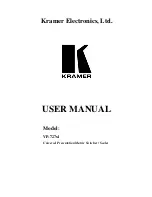
3.5.5 AUTOMATIC LINE EVALUATION (ALE)
The ALE provides a daily summary report of digital subscriber lines (DSL) that have experienced transmission or
protocol faults during that day. The report is composed of three parts: level 1, level 2, and protocol error records
(PER).
The level 1 portion of the report includes all U-interface DSLs where the level 1 error performance has exceeded a
prespecified threshold. The threshold for each DSL is defined by the daily report threshold maintained on RC/V view
22.15, Performance Monitoring Groups. The group that is assigned to a DSL is given in RC/V views 22.7, 23.2, and
23.8. For more information on the contents of the level 1 summary report, see the
EXC:ALE,LEVEL1
output
message.
The level 2 portion of the report includes all IDSN DSLs and trunks where the level 2 error performance has
exceeded a prespecified threshold, that is, more than 2 percent of the received layer 2 frames have been received
in error. For more information on the contents of the level 2 summary report, see the
EXC:ALE,LEVEL2
output
message.
The PER portion of the report includes all ISDN DSLs and trunks where at least one PER has been recorded. For
more information on the contents of the PER summary report, see the
EXC:ALE-PER
output message.
Each of the summaries may be separately allowed or inhibited for the entire office. Also, the information for the
reports may be directed at one of two message classes, that is, PRFM or PRFMMON. See the
ALW:ALE
and
INH:ALE
input messages for details.
The execution time for the daily automatic report is determined using RC/V view 8.1 to specify the performance
monitoring start time. In addition to the daily level 1 report, there are also level 1 interval reports. These interval
reports will report all U-interface DSLs that have exceeded their respective interval report thresholds maintained on
RC/V view 22.15, Performance Monitoring Groups. U-interface DSL line card is supported by the interval report
feature. The Lucent Technologies AMI U-interface DSL line card is not supported. Interval reports are not output.
They are directed to the disks where the last interval report generated is available upon demand.
The hours between interval reports is determined by the performance monitoring REPORT INT global parameter
maintained on RC/V view 8.1. The default interval is 1 (one) and can be set to values that are factors of 24 (1, 2, 3,
4, 6, 8, 12, 24).
For each DSL that is indicated on the level 1 or level 2 report summary, follow procedures specified in 235-105-220
for clearing line problems.
3.5.6 PER-CALL TEST FAILURE (PCTF)
A REPT PCTF SUMMARY report is sent to the ROP on a periodic basis determined by the value in the PCTF
interval global parameter (see RC/V view 8.1). The summary report contains an entry for each port and High-Level
Service Circuit (HLSC) which has experienced at least one PCTF since the previous automatically generated report
was output. Each entry will indicate the PCTFs that have occurred by their type and count.
The PCTF report period can be set to occur every 15 minutes, 30 minutes, 45 minutes, 60 minutes, 6 hours, or 24
hours. The default is every 60 minutes (1 hour).
In addition to the automatic summary reports, the ability to manually request PCTF summary reports is provided via
the input message
OP:PCTF
. Termination of the manual reports can be requested by entering the new
STP:PCTF
input message. By default, the summary reports will also be sent to the Switching Control Center (SCC).
The reporting of the individual PCTFs is controlled by the PCTF verbose option on a per-SM/SM-2000 basis. The
PCTF verbose option can be altered via the
ALW:PCTF,VERBOSE
or
INH:PCTF,VERBOSE
input messages.
235-105-210
October 1999
Copyright © 1999
Page 12
Summary of Contents for 5ESS-2000
Page 96: ...235 105 210 October 1999 Copyright 1999 Page 2 ...
Page 184: ...235 105 210 October 1999 Copyright 1999 Page 3 ...
Page 300: ...13 STOP YOU HAVE COMPLETED THIS PROCEDURE 235 105 210 October 1999 Copyright 1999 Page 55 ...
Page 339: ...7 STOP YOU HAVE COMPLETED THIS PROCEDURE 235 105 210 October 1999 Copyright 1999 Page 13 ...
Page 342: ...235 105 210 October 1999 Copyright 1999 Page 2 ...
Page 359: ...235 105 210 October 1999 Copyright 1999 Page 5 ...
Page 609: ...2 STOP YOU HAVE COMPLETED THIS PROCEDURE 235 105 210 October 1999 Copyright 1999 Page 12 ...
Page 676: ...235 105 210 October 1999 Copyright 1999 Page 9 ...
Page 792: ...3 STOP YOU HAVE COMPLETED THIS PROCEDURE 235 105 210 October 1999 Copyright 1999 Page 9 ...
Page 799: ...Figure 11 36 3 1 Cleaning Points 235 105 210 October 1999 Copyright 1999 Page 7 ...
Page 801: ...235 105 210 October 1999 Copyright 1999 Page 9 ...
Page 839: ...2 STOP YOU HAVE COMPLETED THIS PROCEDURE 235 105 210 October 1999 Copyright 1999 Page 16 ...
Page 999: ...2 STOP YOU HAVE COMPLETED THIS PROCEDURE 235 105 210 October 1999 Copyright 1999 Page 13 ...
Page 1008: ...Figure 11 55 1 CTSNS DIP Switch Settings 235 105 210 October 1999 Copyright 1999 Page 2 ...
Page 1011: ...235 105 210 October 1999 Copyright 1999 Page 5 ...
Page 1053: ...235 105 210 October 1999 Copyright 1999 Page 15 ...
Page 1289: ...Figure 15 17 2 AMATPS Data Link 235 105 210 October 1999 Copyright 1999 Page 2 ...
Page 1292: ...235 105 210 October 1999 Copyright 1999 Page 5 ...
Page 1303: ...9 STOP YOU HAVE COMPLETED THIS PROCEDURE 235 105 210 October 1999 Copyright 1999 Page 2 ...
Page 1360: ...Figure 15 47 2 Typical SCANS III Link Diagram 235 105 210 October 1999 Copyright 1999 Page 2 ...
Page 1372: ...235 105 210 October 1999 Copyright 1999 Page 2 ...
Page 1374: ...235 105 210 October 1999 Copyright 1999 Page 4 ...
Page 1421: ...Table 1 1 O M Checklist 235 105 210 October 1999 Copyright 1999 Page 3 ...
















































